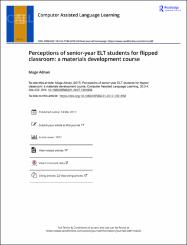Perceptions of senior-year ELT students for flipped classroom: a materials development course
Abstract
This paper describes a structured attempt to integrate the flipped classroom model into a senior-level course at the higher education level. This study's purpose is to examine and compare the impact of flipped classrooms versus non-flipped as a means to contribute to the growing line of research on flipped teaching through an evaluation of both methods' academic outcomes, along with students' perceptions for their learning experience. Adopting action research principles, this study uses student grades, weekly e-journal entries, guided final journal entries, and focus group interviews as data collection tools. No significant difference were found to exist between mean scores for flipped and non-flipped groups regarding midterms and final e-portfolio, but flipped students received significantly higher essay scores compared to the non-flipped. Analysis of qualitative data led to 48 codes under five main categories: content delivery, instructor presence, learner presence, learning environment, and learning experience. Results indicate largely positive perceptions and satisfying learning experiences.


















